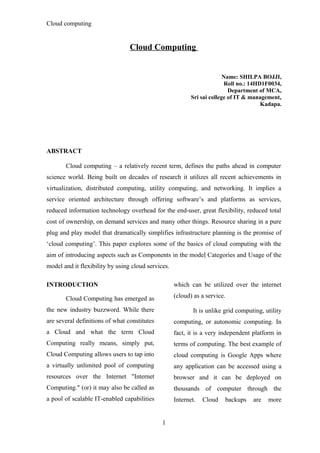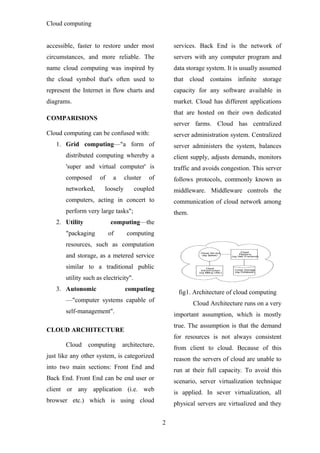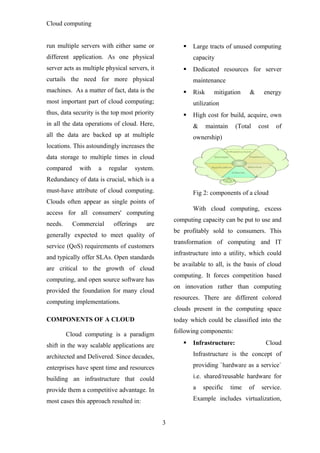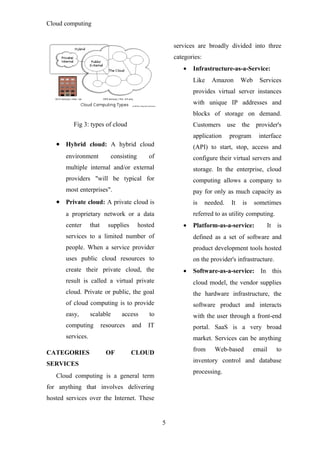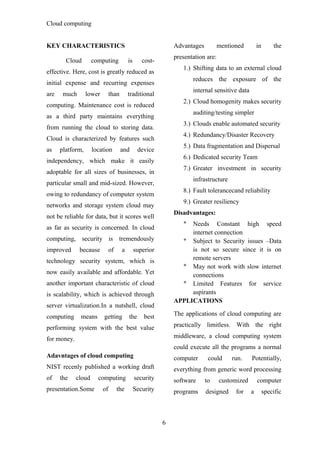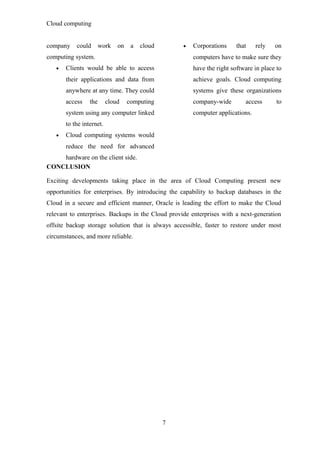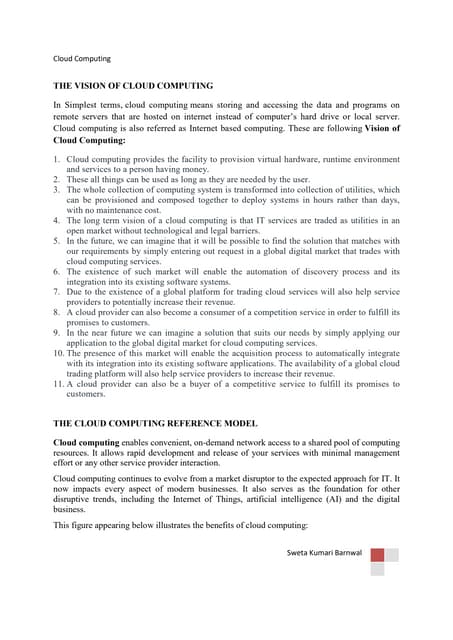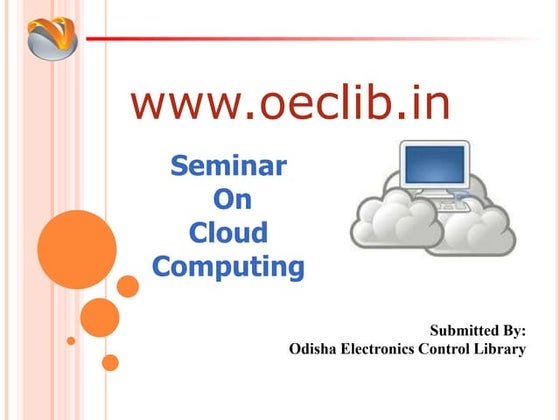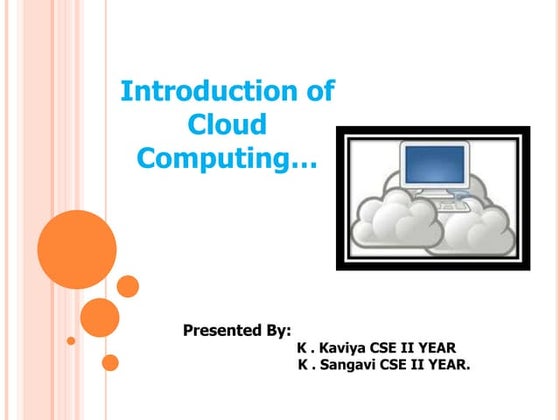cloud computing documentation
- 1. Cloud computing Cloud Computing Name: SHILPA BOJJI, Roll no.: 14HD1F0034, Department of MCA, Sri sai college of IT & management, Kadapa. ABSTRACT Cloud computing ŌĆō a relatively recent term, defines the paths ahead in computer science world. Being built on decades of research it utilizes all recent achievements in virtualization, distributed computing, utility computing, and networking. It implies a service oriented architecture through offering softwareŌĆÖs and platforms as services, reduced information technology overhead for the end-user, great flexibility, reduced total cost of ownership, on demand services and many other things. Resource sharing in a pure plug and play model that dramatically simplifies infrastructure planning is the promise of ŌĆścloud computingŌĆÖ. This paper explores some of the basics of cloud computing with the aim of introducing aspects such as Components in the model ’ĆĀCategories and Usage of the model and it flexibility by using cloud services. INTRODUCTION Cloud Computing has emerged as the new industry buzzword. While there are several definitions of what constitutes a Cloud and what the term Cloud Computing really means, simply put, Cloud Computing allows users to tap into a virtually unlimited pool of computing resources over the Internet "Internet Computing." (or) it may also be called as a pool of scalable IT-enabled capabilities which can be utilized over the internet (cloud) as a service. It is unlike grid computing, utility computing, or autonomic computing. In fact, it is a very independent platform in terms of computing. The best example of cloud computing is Google Apps where any application can be accessed using a browser and it can be deployed on thousands of computer through the Internet. Cloud backups are more 1
- 2. Cloud computing accessible, faster to restore under most circumstances, and more reliable. The name cloud computing was inspired by the cloud symbol that's often used to represent the Internet in flow charts and diagrams. COMPARISIONS Cloud computing can be confused with: 1. Grid computingŌĆö"a form of distributed computing whereby a 'super and virtual computer' is composed of a cluster of networked, loosely coupled computers, acting in concert to perform very large tasks"; 2. Utility computingŌĆöthe "packaging of computing resources, such as computation and storage, as a metered service similar to a traditional public utility such as electricity". 3. Autonomic computing ŌĆö"computer systems capable of self-management". CLOUD ARCHITECTURE Cloud computing architecture, just like any other system, is categorized into two main sections: Front End and Back End. Front End can be end user or client or any application (i.e. web browser etc.) which is using cloud services. Back End is the network of servers with any computer program and data storage system. It is usually assumed that cloud contains infinite storage capacity for any software available in market. Cloud has different applications that are hosted on their own dedicated server farms. Cloud has centralized server administration system. Centralized server administers the system, balances client supply, adjusts demands, monitors traffic and avoids congestion. This server follows protocols, commonly known as middleware. Middleware controls the communication of cloud network among them. fig1. Architecture of cloud computing Cloud Architecture runs on a very important assumption, which is mostly true. The assumption is that the demand for resources is not always consistent from client to cloud. Because of this reason the servers of cloud are unable to run at their full capacity. To avoid this scenario, server virtualization technique is applied. In sever virtualization, all physical servers are virtualized and they 2
- 3. Cloud computing run multiple servers with either same or different application. As one physical server acts as multiple physical servers, it curtails the need for more physical machines. As a matter of fact, data is the most important part of cloud computing; thus, data security is the top most priority in all the data operations of cloud. Here, all the data are backed up at multiple locations. This astoundingly increases the data storage to multiple times in cloud compared with a regular system. Redundancy of data is crucial, which is a must-have attribute of cloud computing. Clouds often appear as single points of access for all consumers' computing needs. Commercial offerings are generally expected to meet quality of service (QoS) requirements of customers and typically offer SLAs. Open standards are critical to the growth of cloud computing, and open source software has provided the foundation for many cloud computing implementations. COMPONENTS OF A CLOUD Cloud computing is a paradigm shift in the way scalable applications are architected and Delivered. Since decades, enterprises have spent time and resources building an infrastructure that could provide them a competitive advantage. In most cases this approach resulted in: ’é¦ Large tracts of unused computing capacity ’é¦ Dedicated resources for server maintenance ’é¦ Risk mitigation & energy utilization ’é¦ High cost for build, acquire, own & maintain (Total cost of ownership) Fig 2: components of a cloud With cloud computing, excess computing capacity can be put to use and be profitably sold to consumers. This transformation of computing and IT infrastructure into a utility, which could be available to all, is the basis of cloud computing. It forces competition based on innovation rather than computing resources. There are different colored clouds present in the computing space today which could be classified into the following components: ’é¦ Infrastructure: Cloud Infrastructure is the concept of providing `hardware as a service` i.e. shared/reusable hardware for a specific time of service. Example includes virtualization, 3
- 4. Cloud computing grid computing, and paravirtualization. ’é¦ Storage: Cloud Storage is the concept of separating data from processing and storing in a remote place. Cloud Storage also includes database services. Examples are GoogleŌĆÖs BigTable, AmazonŌĆÖs Simple DB etc. ’é¦ Platform: A Cloud Platform is a service for application deployment and managing the required hardware & software needs. This could be a single service platform or a solution stack. Examples include Web application frameworks, Web hosting etc. ’é¦ Application: A Cloud Application is an offering of software architecture that eliminates the need to install, run and maintain an application at the userŌĆÖs desktop/device.It eliminates the cost/resources required to maintain and/or support applications. ’é¦ Services: A Cloud Service is an independent piece of software which can be used in conjunction with other services to achieve an interoperable machine-to- machine interaction over the network. Examples include AmazonŌĆÖs Simple Queue Service, Google maps, AmazonŌĆÖs flexible payment service etc. ’é¦ Client: Cloud Client is a requester software or hardware device which tries to utilize cloud computing services over the network. The client device could be a Web browser, PC, laptop or mobile etc. TYPES OF CLOUD ŌĆó Public cloud: Public cloud or external cloud describes cloud computing in the traditional mainstream sense, whereby resources are dynamically provisioned on a fine-grained, self-service basis over the Internet, via web applications /web services, from an off-site third-party provider who shares resources and bills on a fine- grained utility computing basis. A public cloud sells services to anyone on the Internet. (Currently, Amazon Web Services is the largest public cloud provider.) 4
- 5. Cloud computing Fig 3: types of cloud ŌĆó Hybrid cloud: A hybrid cloud environment consisting of multiple internal and/or external providers "will be typical for most enterprises". ŌĆó Private cloud: A private cloud is a proprietary network or a data center that supplies hosted services to a limited number of people. When a service provider uses public cloud resources to create their private cloud, the result is called a virtual private cloud. Private or public, the goal of cloud computing is to provide easy, scalable access to computing resources and IT services. CATEGORIES OF CLOUD SERVICES Cloud computing is a general term for anything that involves delivering hosted services over the Internet. These services are broadly divided into three categories: ŌĆó Infrastructure-as-a-Service: Like Amazon Web Services provides virtual server instances with unique IP addresses and blocks of storage on demand. Customers use the provider's application program interface (API) to start, stop, access and configure their virtual servers and storage. In the enterprise, cloud computing allows a company to pay for only as much capacity as is needed. It is sometimes referred to as utility computing. ŌĆó Platform-as-a-service: It is defined as a set of software and product development tools hosted on the provider's infrastructure. ŌĆó Software-as-a-service: In this cloud model, the vendor supplies the hardware infrastructure, the software product and interacts with the user through a front-end portal. SaaS is a very broad market. Services can be anything from Web-based email to inventory control and database processing. 5
- 6. Cloud computing KEY CHARACTERISTICS Cloud computing is cost- effective. Here, cost is greatly reduced as initial expense and recurring expenses are much lower than traditional computing. Maintenance cost is reduced as a third party maintains everything from running the cloud to storing data. Cloud is characterized by features such as platform, location and device independency, which make it easily adoptable for all sizes of businesses, in particular small and mid-sized. However, owing to redundancy of computer system networks and storage system cloud may not be reliable for data, but it scores well as far as security is concerned. In cloud computing, security is tremendously improved because of a superior technology security system, which is now easily available and affordable. Yet another important characteristic of cloud is scalability, which is achieved through server virtualization.In a nutshell, cloud computing means getting the best performing system with the best value for money. Adavntages of cloud computing NIST recenly published a working draft of the cloud computing security presentation.Some of the Security Advantages mentioned in the presentation are: 1.) Shifting data to an external cloud reduces the exposure of the internal sensitive data 2.) Cloud homogenity makes security auditing/testing simpler 3.) Clouds enable automated security 4.) Redundancy/Disaster Recovery 5.) Data fragmentation and Dispersal 6.) Dedicated security Team 7.) Greater investment in security infrastructure 8.) Fault tolerancecand reliability 9.) Greater resiliency Disadvantages: * Needs Constant high speed internet connection * Subject to Security issues ŌĆōData is not so secure since it is on remote servers * May not work with slow internet connections * Limited Features for service aspirants APPLICATIONS The applications of cloud computing are practically limitless. With the right middleware, a cloud computing system could execute all the programs a normal computer could run. Potentially, everything from generic word processing software to customized computer programs designed for a specific 6
- 7. Cloud computing company could work on a cloud computing system. ŌĆó Clients would be able to access their applications and data from anywhere at any time. They could access the cloud computing system using any computer linked to the internet. ŌĆó Cloud computing systems would reduce the need for advanced hardware on the client side. ŌĆó Corporations that rely on computers have to make sure they have the right software in place to achieve goals. Cloud computing systems give these organizations company-wide access to computer applications. CONCLUSION Exciting developments taking place in the area of Cloud Computing present new opportunities for enterprises. By introducing the capability to backup databases in the Cloud in a secure and efficient manner, Oracle is leading the effort to make the Cloud relevant to enterprises. Backups in the Cloud provide enterprises with a next-generation offsite backup storage solution that is always accessible, faster to restore under most circumstances, and more reliable. 7
